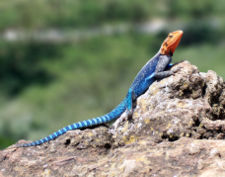| Agamids | ||||||||||||
|---|---|---|---|---|---|---|---|---|---|---|---|---|
 |
||||||||||||
| Scientific classification | ||||||||||||
|
||||||||||||
|
Agaminae Leiolepidinae Draconinae |
Agamids or lizards of the family Agamidae include more than 300 species in Africa, Asia, Australia, and a few in Southern Europe. Phylogenetically they may be sister to the Iguanidae, characterized by predominantly acrodont dentition. Agamids usually have well-developed, strong legs. Their tails cannot be shed and regenerated like those of Geckoes, though a certain amount of regeneration is observed in some. Many agamid species are capable of limited change of their colours. Ecologically they range from hot deserts to tropical rainforests.
There have been very few studies of the Agamidae with the first comprehensive assessment by Moody (1980) followed by a more inclusive assessment by Frost and Etheridge (1989). Subsequent studies were based mitochondrial DNA loci with Macey et al. (2000) and Honda et al. (2000) and Joger (1991)(using allozymes) sampling across the Agamidae. Few other studies focused on clades within the family, but the Agamidae have not been as well investigated as the Iguanidae.
Among the Agamidae, six clades or lineages are generally recognized including the Leiolepidinae (Leiolepis), Uromasticinae (Uromastyx), Amphibolurinae (Australian and New Guinean), Hydrosaurinae (Hydrosaurus), Draconinae (South and Southeast Asian), and Agaminae (African and Arabian). The Chamaeleons of the sister family Chamaeleonidae are sometimes discussed as sub-family Chamaeleoninae and sub-family Agaminae (referring to Agamidae, not the Agaminae mentioned above).
External link
Agamids, lizards, family Agamidae, species, Africa, Asia, Australia, Southern Europe. Phylogenetically, Iguanidae, characterized, predominantly, acrodont dentition